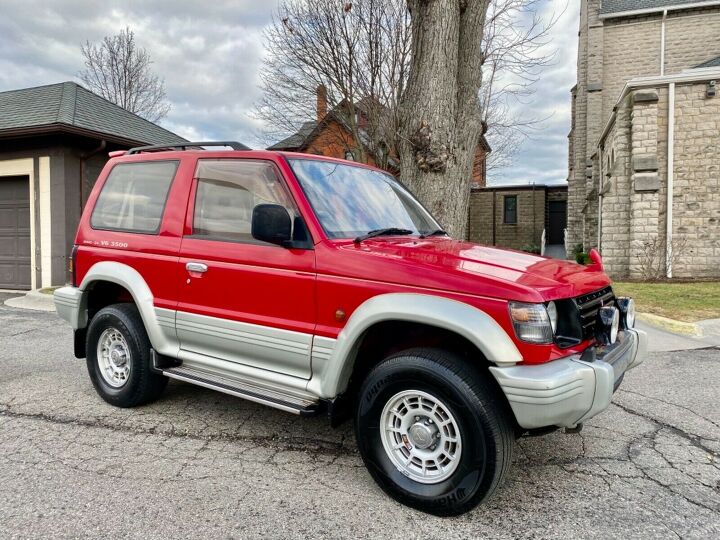Rare Rides: The 1995 Mitsubishi Pajero, Montero's Forbidden Sibling

Rare Rides has touched on the first generation Pajero (Montero to North Americans) once before via the Raider, a captive import Dodge dealers could shift while the company had zero small SUV action of its own. Today’s Pajero is a second-generation version – the three-door never sold on our shores. Surprisingly, it even maintains the same color scheme as the Raider.
The first generation Pajero entered production for the 1983 model year, originally in three-door guise. The five-door version joined it shortly thereafter and quickly became the volume model of Montero in North America. By the end of the Eighties though, the old box was due for a do-over. Mitsubishi debuted its new Pajero to the Japanese market early in 1991, then sold off the old tooling to South Korea. Suddenly, Hyundai had a new family SUV to sell! Said newly created Galloper remained in production through 2004.
Available in its second form in three- and five-door guises, the new Pajero was a big step forward over the prior version. Considerably reworked, almost everything was new for ’91. Larger and available with more power underhood, the Pajero proved very popular and branched out in its production. While the model’s second generation was produced in Japan between 1991 and 1999, it was produced in four other locations as well. The Philippines made some from 1993 through 2008, Columbia had their own production from 1994 to 2012, and it was produced under license in Iran from 2005 to 2007 by a company called Bahman Group. But nothing compares to China’s love for the gen two Pajero. Beginning in 1997, the Pajero was transformed into Chinese SUVs via a joint venture between Mitsubishi and various Chinese institutions. It was sold as 12 different vehicles in the Chinese market, and remained in production through December 2019, as the Changfeng Liebao Q6. Now that’s some product longevity.
Engines in use outside China (they had their own versions) included inline-fours of 2.4 and 2.6 liters in displacement, and V6 engines in 3.0- and 3.5-liters. There were also diesel mills with four cylinders, sized at 2.5 liters and 2.8 liters. Transmissions were of four or five speeds if automatic, or five speeds if manual.
Stateside, Mitsubishi imported the Montero as a five-door affair only, unsatisfied with the first generation three-door’s slow sales. Diesel engines and manual transmissions were no longer available in North America, and the only power underhood was a V6. Mitsubishi updated the Montero over the years, and gradually added gingerbread, power, and luxury items to bring it in line with competition like the Isuzu Trooper and more expensive Toyota Land Cruiser. The second-generation Montero lived through the 2000 model year and bowed out in the loaded Endeavor trim. The much more modern third generation took its place in 2001.
Today’s Rare Ride is a well-equipped three-door Pajero fresh from the Japanese market. Its owner was okay paying the additional taxes on a large displacement vehicle and chose the 3.5-liter V6 and an automatic. With 42,000 miles, this one sold a couple of weeks ago for $8,100.
[Images: seller]

Interested in lots of cars and their various historical contexts. Started writing articles for TTAC in late 2016, when my first posts were QOTDs. From there I started a few new series like Rare Rides, Buy/Drive/Burn, Abandoned History, and most recently Rare Rides Icons. Operating from a home base in Cincinnati, Ohio, a relative auto journalist dead zone. Many of my articles are prompted by something I'll see on social media that sparks my interest and causes me to research. Finding articles and information from the early days of the internet and beyond that covers the little details lost to time: trim packages, color and wheel choices, interior fabrics. Beyond those, I'm fascinated by automotive industry experiments, both failures and successes. Lately I've taken an interest in AI, and generating "what if" type images for car models long dead. Reincarnating a modern Toyota Paseo, Lincoln Mark IX, or Isuzu Trooper through a text prompt is fun. Fun to post them on Twitter too, and watch people overreact. To that end, the social media I use most is Twitter, @CoreyLewis86. I also contribute pieces for Forbes Wheels and Forbes Home.
More by Corey Lewis
Latest Car Reviews
Read moreLatest Product Reviews
Read moreRecent Comments
- Brian Uchida Laguna Seca, corkscrew, (drying track off in rental car prior to Superbike test session), at speed - turn 9 big Willow Springs racing a motorcycle,- at greater speed (but riding shotgun) - The Carrousel at Sears Point in a 1981 PA9 Osella 2 litre FIA racer with Eddie Lawson at the wheel! (apologies for not being brief!)
- Mister It wasn't helped any by the horrible fuel economy for what it was... something like 22mpg city, iirc.
- Lorenzo I shop for all-season tires that have good wet and dry pavement grip and use them year-round. Nothing works on black ice, and I stopped driving in snow long ago - I'll wait until the streets and highways are plowed, when all-seasons are good enough. After all, I don't live in Canada or deep in the snow zone.
- FormerFF I’m in Atlanta. The summers go on in April and come off in October. I have a Cayman that stays on summer tires year round and gets driven on winter days when the temperature gets above 45 F and it’s dry, which is usually at least once a week.
- Kwik_Shift_Pro4X I've never driven anything that would justify having summer tires.








































Comments
Join the conversation
Wasn't there a Raider truck briefly which was a thinly disguised reskin of a Dakota?
Ford might use the Pinto name for a subcompact pickup since Ford is using the name Maverick for a new compact pickup that will be released next Spring.